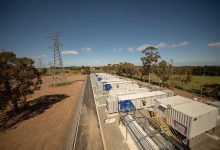Frustration is mounting at the high degree of difficulty of connecting big batteries to Australia’s grid, with one renewables developer reportedly lamenting that the only tougher market for large-scale energy storage might be the Moon.
That comment, which came from an unnamed source, was related to RenewEconomy this week by Matt Penfold, an Australian who currently works from the US as vice president of commercial on the digital team at energy storage technology and bidding software leader Fluence.
The sentiment mirrors the exasperation expressed, also this week, by the head of one of Australia’s leading renewable energy developers, Tilt Renewables, at his company’s inability to obtain approval to add a big battery to one of its operating wind farms in South Australia. See: “I don’t get it: Why an old wind farm is unable to add a new big battery
As RenewEconomy reported, Tilt has been looking for several years into adding a battery to its Snowtown wind complex in South Australia, where it still owns the 101MW Snowtown 1 wind farm.
But CEO Deion Campbell said the company had effectively been told by the local transmission company ElectraNet that it would not be possible without significant modelling and an adjustment to the project’s generator performance standard (GPS).
Campbell said these tortuous requirements made adding energy storage to the wind farm virtually impossible, and the company would now focus instead on “stand-alone” battery developments in Victoria.
“I’ve seen a lot of people really struggling to get batteries connected and struggling to navigate [the Australian Energy Market Operator’s] GPS process to get the assets plugged in,” Fluence’s Penfold said in a separate and completely unrelated interview with RenewEconomy on Thursday.
“And you know, that leads into those challenges getting financing and all that sort of thing,” he added. “So this is a real challenge and someone told me the other day that the only place harder to connect a battery than Australia was the Moon.”
Fluence, itself a joint venture between global energy giant Siemens and AES, has built two big batteries in Australia – at Ballarat and at the Lincoln Gap wind farm, and has proposed giant “twin” batteries to help expand the capacity of the main link between the NSW and Victoria grids.
Penfold, who in his previous role worked at leading bidding software company AMS, which was last year acquired by Fluence, said it would be great to see big batteries “flying off the rack” like they were in California, but that for this to happen a number of key changes would need to be made.
“My understanding is that AEMO is doing their best, but anything that we think can be done to alleviate those those burdens on developers within, obviously, the constraints of system reliability and ensuring we don’t have outages and blackouts and things, [would be welcomed].
“I’d also love to [see] … the AEMC (Australian Energy Market Commission) and other other thought leaders… thinking about how do we encourage and reward the value that batteries can provide, because currently, you know, batteries do a lot more than just energy arbitrage and regulation and contingency FCAS, and they’re not necessarily paid for those services.
“So I think that can also be an opportunity to look again at those products and capacity payments and what-have-you to ensure that we’re getting the right changes in the grid as we see these coal and conventional resource retirements,” Penfold said.
“The sooner we can get these market products in the market, such that developers who are evaluating storage can look at this and say this is an upside revenue stream for me, I can feel comfortable building a battery …off the back of these revenue streams, we will see a much faster transformation in the NEM and, really, that decarbonisation that most of us hope to see.”
His comments came as Fluence announced it was seeing a mini-boom in new wind, solar and battery energy storage contracts for its automatic trading platform in Australia, notching up 1.5GW of new partnerships in just six months since its acquisition of leading bidding software company AMS.
It says new customers include Spark Renewables (part of the Spark Infrastructure Group) and BJCE, and has taken Fluence’s total number of assets using the algorithmic trading and bidding optimisation platform to more than 3.4GW.
That number includes operating assets representing roughly 18% of all grid-scale wind and solar capacity in the Australian National Electricity Market (NEM) as well as one of the largest battery-based energy storage assets in the world in California.
Most are keen to be able to dodge negative prices – in the case of wind and solar – or maximise their arbitrage in the case of battery storage.
“It took us ….almost two years to get to 2GW and then in eight months we’ve added another 1.5GW,” said Penfold.
“I think we’re solving a problem that the market is really struggling with, which is the increased frequency of negative prices, increased volatility, high FCAS (frequency control ancillary services) prices… local constraints.
“I’m super excited by how this technology has jumped out of Australia and is being applied in other markets and really this sort of Australian-spawned technology is really making a big difference in markets like California and Texas.”








